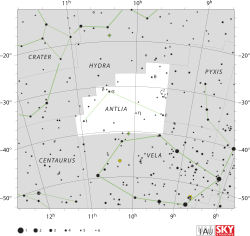Epsilon Antliae
Epsilon Antliae (ε Ant, ε Antliae) is the Bayer designation for a star in the southern constellation of Antlia. The apparent visual magnitude of this star is +4.51,[2] which means it is visible to the naked eye. From parallax measurements, the distance to this star is known to be 590 ± 30 light-years (180.9 ± 9.2 parsecs). Photometry measurements during the Hipparcos mission indicate that this star is undergoing periodic variability by 0.0034 magnitudes over an 11.07941 day cycle.[10]
 | |
| Observation data Epoch J2000 Equinox J2000 | |
|---|---|
| Constellation | Antlia |
| Right ascension | 09h 29m 14.71968s[1] |
| Declination | –35° 57′ 04.8074″[1] |
| Apparent magnitude (V) | +4.51[2] |
| Characteristics | |
| Spectral type | K3 IIIa[3] |
| U−B color index | +1.68[4] |
| B−V color index | +1.44[4] |
| Astrometry | |
| Radial velocity (Rv) | +22.2[2] km/s |
| Proper motion (μ) | RA: −24.774±0.306[5] mas/yr Dec.: +5.702±0.357[5] mas/yr |
| Parallax (π) | 5.5233 ± 0.2778[5] mas |
| Distance | 590 ± 30 ly (181 ± 9 pc) |
| Absolute magnitude (MV) | −2.17[6] |
| Details | |
| Radius | 37[7] R☉ |
| Luminosity | 1,279[8] L☉ |
| Temperature | 4,320[8] K |
| Other designations | |
| Database references | |
| SIMBAD | data |
The stellar classification of this star is K3 IIIa,[3] where the luminosity class of III indicates that this is an evolved giant star. It is around 37 times the radius of the Sun.[7] and shines with a luminosity approximately 1279 times that of the Sun and has a surface temperature of 4320 K.[8]
References
- van Leeuwen, F. (November 2007), "Validation of the new Hipparcos reduction", Astronomy and Astrophysics, 474 (2): 653–664, arXiv:0708.1752, Bibcode:2007A&A...474..653V, doi:10.1051/0004-6361:20078357.
- Wielen, R.; et al. (1999), Sixth Catalogue of Fundamental Stars (FK6). Part I. Basic fundamental stars with direct solutions, Astronomisches Rechen-Institut Heidelberg, Bibcode:1999VeARI..35....1W.
- Eggleton, P. P.; Tokovinin, A. A. (September 2008). "A catalogue of multiplicity among bright stellar systems". Monthly Notices of the Royal Astronomical Society. 389 (2): 869–879. arXiv:0806.2878. Bibcode:2008MNRAS.389..869E. doi:10.1111/j.1365-2966.2008.13596.x.
- Johnson, H. L.; et al. (1966), "UBVRIJKL photometry of the bright stars", Communications of the Lunar and Planetary Laboratory, 4 (99), Bibcode:1966CoLPL...4...99J.
- Brown, A. G. A.; et al. (Gaia collaboration) (August 2018). "Gaia Data Release 2: Summary of the contents and survey properties". Astronomy & Astrophysics. 616. A1. arXiv:1804.09365. Bibcode:2018A&A...616A...1G. doi:10.1051/0004-6361/201833051. Gaia DR2 record for this source at VizieR.
- Anderson, E.; Francis, Ch. (2012), "XHIP: An extended hipparcos compilation", Astronomy Letters, 38 (5): 331, arXiv:1108.4971, Bibcode:2012AstL...38..331A, doi:10.1134/S1063773712050015.
- Pasinetti-Fracassini, L. E.; et al. (February 2001), "Catalogue of Stellar Diameters (CADARS)", Astronomy and Astrophysics, 367: 521–524, arXiv:astro-ph/0012289, Bibcode:2001A&A...367..521P, doi:10.1051/0004-6361:20000451.
- McDonald, I.; Zijlstra, A. A.; Boyer, M. L. (2012). "Fundamental Parameters and Infrared Excesses of Hipparcos Stars". Monthly Notices of the Royal Astronomical Society. 427 (1): 343–57. arXiv:1208.2037. Bibcode:2012MNRAS.427..343M. doi:10.1111/j.1365-2966.2012.21873.x.
- "eps Ant". SIMBAD. Centre de données astronomiques de Strasbourg. Retrieved 2012-06-25.
- Koen, Chris; Eyer, Laurent (March 2002), "New periodic variables from the Hipparcos epoch photometry", Monthly Notices of the Royal Astronomical Society, 331 (1): 45–59, arXiv:astro-ph/0112194, Bibcode:2002MNRAS.331...45K, doi:10.1046/j.1365-8711.2002.05150.x.